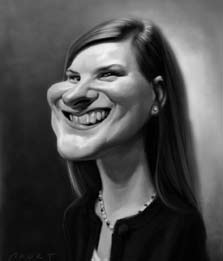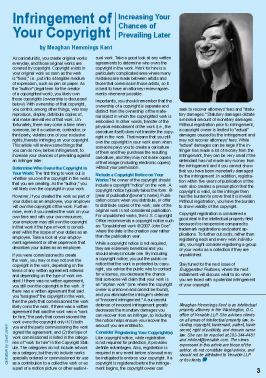Infringement of Your Copyright: Increasing Your Chances of Prevailing Later
 | |
| Author | Meaghan Hemmings Kent |
|---|---|
| Genre | |
| Published | EF Issue 2009.2 |
Publication date | Spring 2009 |
| Media type |
|
| Pages | 3 |
| Website |
|
| Meaghan Hemmings Kent is an intellectual property attorney in the Washington, D.C. office of Venable
LLP. She advises clients on all areas of intellectual property law, including copyright, trademark, patent, trade secret, right of publicity, and domain name law. She can be reached at 202-344-4481 and mhkent@venable.com. The views expressed in this article are those of the author, do not constitute legal advice, and should not be attributed to Venable LLP or its clients. | |
Article Description. Should include author, brief description, issue number and page number(s).
Article Transcript
As caricaturists, you create original works everyday, and those original works are covered by copyright. Copyright exists in your original work as soon as the work is “fixed,” i.e., put into a tangible medium of expression, such as pen on paper. As the “author” (legal term for the creator of a copyrighted work), you likely own those copyrights (ownership is discussed below). With ownership of that copyright, you control, among other things, who may reproduce, display, distribute copies of, and make derivatives of that work. Unfortunately, there may come a time when someone, be it a customer, contractor, or third party, violates one of your exclusive rights, thereby infringing on your copyright. This article will review some things that you can do now, before infringement, to increase your chances of prevailing against an infringer later.
Determine Who Owns the Copyright in Your Work:
The first thing to work out is
whether you own the copyright in the works
that you are creating. As the “author,” you
will likely own the copyright in your work.
However, if you created the work as part of your duties as an employee, your employer will own the copyright of the work. Furthermore, even if you created the work on your own time and with your own resources, your employer may still own the copyright in that work if the type of work is considered within the scope of your duties as an employee. Take a look at your employment agreement or other paperwork that describes your duties as an employee.
If you were commissioned to create the work, you may or may not own the copyright in the work, depending on the terms of any written agreement entered and depending on the type of work created. If there was no written agreement, you still own the copyright in the work. If there was a written agreement that said you “assigned” the copyright in the work, then the party that commissioned the work likely owns the work. If there was a written agreement that said the work was a “work for hire,” the party that commissioned the work owns the copyright only if (1) both you and the party commissioning the work signed the agreement, and (2) the type of work commissioned is listed in the categories of “work for hire” in the Copyright Statute. The categories do not include artwork as a category, but they do include works specially ordered or commissioned for use as a contribution to a collective work or as a part of a motion picture or other audiovisual work. Take a good look at any written agreements to determine who owns the copyright in the work. Work for hire is a particularly complicated area where many mistakes are made between artists and those that commission those artists, so it is best to have an attorney review agreements whenever possible.
Importantly, you should remember that the ownership of a copyright is separate and distinct from the ownership of the material object in which the copyrighted work is embodied. In other words, transfer of the physical embodiment of the work (i.e., the caricature itself) does not transfer the copyright in the work. That means that you still own the copyright in your work even when someone pays you to create a caricature of them and they purchase the resulting caricature, and they may not make copies of that image (including electronic copies) without your permission.
Include a Copyright Notice on Your Works:
The owner of the copyright should
include a copyright “notice” on the work. A
copyright notice typically takes the form: ©
[year of publication][owner’s name]. Publication
occurs when you distribute, or offer
to distribute copies of the work; sale of the
original work is not considered publication.
For unpublished works, the U.S. Copyright
Office recommends a copyright notice such
as: “Unpublished work © 2007 John Doe”
where the date is the creation year rather
than the publication year.
While a copyright notice is not required, they are extremely beneficial and you should always include one. By including a copyright notice, you put the public on notice that the work is protected by copyright, you advise the public who to contact for a license, you decrease the chance that someone will claim that your work is an “orphan work” (one where the copyright owner is unknown and cannot be found), and you eliminate the infringer’s defense of “innocent infringement.” A successful defense of innocent infringement greatly decreases the monetary damages you can recover from an infringer, so including the notice helps ensure you recover the amount you are entitled to.
Consider Registering Your Copyright(s):
Like copyright notice, while registration
is not required for protection, it provides
definite advantages. Also, registration is
required in any event before a lawsuit may
be instigated to enforce your copyright. If a
copyright is registered before the infringement
begins, the copyright owner can
seek to recover attorneys’ fees and “statutory
damages.” Statutory damages dictate
a minimal amount of monetary damages.
Without registration prior to infringement,
a copyright owner is limited to “actual”
damages caused by the infringement and
may not recover attorneys’ fees. While
“actual” damages can be large if the infringer
has made a lot of money from the
infringement, they can be very small if the
defendant has not made any money from
the infringement and if you cannot show
that you have been monetarily damaged
by the infringement. In addition, registration
within five years of publication of the
work also creates a presumption that the
copyright is valid, so the infringer then
has the burden to prove that it is invalid.
Without registration, you have the burden
to show validity of the copyright.
Copyright registration is considered a good deal in the intellectual property field because it is inexpensive compared to trademark registrations and patent applications. To further cut costs, rather than registering each and every work individually, you might consider registering a group of your works as a collection if they are unpublished.
Stay tuned for the next issue of Exaggerated Features, where the next installment will discuss what to do when you are faced with a potential infringement of your copyright.
See Also
External Links
This Navigation box may not show up on mobile browsers. Please see Exaggerated Features Issue 2009.2 for the full contents of this issue if the navigation box does not display.

